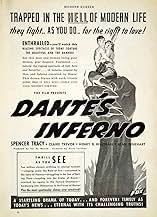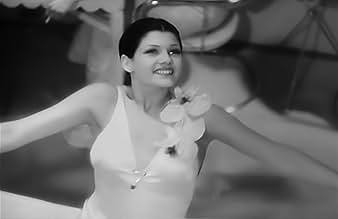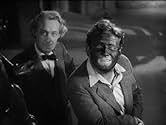Ajouter une intrigue dans votre langueJim Carter moves in on the McWade's carnival concession which shows scenes from Dante's "Inferno". He makes it a going concern, marrying Betty along the way. An inspector calls the amusement... Tout lireJim Carter moves in on the McWade's carnival concession which shows scenes from Dante's "Inferno". He makes it a going concern, marrying Betty along the way. An inspector calls the amusement pier unsafe but Carter bribes him. The pier collapses, leading to the inspector's suicide... Tout lireJim Carter moves in on the McWade's carnival concession which shows scenes from Dante's "Inferno". He makes it a going concern, marrying Betty along the way. An inspector calls the amusement pier unsafe but Carter bribes him. The pier collapses, leading to the inspector's suicide, injury to Pop McWade, trial for Carter, and Betty's leaving him. Carter starts over with... Tout lire
- Réalisation
- Scénario
- Casting principal
- Récompenses
- 1 nomination au total
- Alexander Carter
- (as Scott Beckett)
- Dancer
- (as Rita Cansino)
- Girl in Stoke-Hold
- (non crédité)
- Man in Stoke-Hold
- (non crédité)
- Mr. Williams
- (non crédité)
- Girl in Stoke-Hold
- (non crédité)
- Concessionaire's Wife
- (non crédité)
- Photographer
- (non crédité)
- Passenger in Boiler Room
- (non crédité)
- Amusement Park Patron
- (non crédité)
Avis à la une
Nothing quite that gaudy here - The central figure (Tracy) begins as a stoker, but slowely rises in the world, frequently not realizing that his greed and drive have alienated friends and relatives. The source of his wealth is the carnival and gambling empire he has put together. In the course of building it he meets Henry Walthall, who wants to build a midway building that shows Dante's Inferno - Walthall believes it will be beneficial to the public as it will show the public the dangerous ice they are on if they continue to sin. Of course this is the screenwriter's take on Dante's Divine Comedy, and the Inferno in particular - actually Dante is far too clever a poet to have such a trivial motive in the actual work for writing it that way.
That Tracy is saved in the end is due to heeding the wisdom of his friend (later his father-in-law)and due to a sea tragedy - Tracy's latest addition to his empire is a gambling ship, which catches fire off the coast of the U.S., and requires Tracy's leadership qualities to save the passengers and crew. A suitable fiery conclusion to the film - and also an historic footnote: the boat is made to resemble the ill-fated Morro Castle, which burned in a fire in 1934 (the year before this film) off the coast of New Jersey, killing 130 passengers and crew. As such, this is the sole movie I know of that refers to that disaster, except for a line of dialogue in the contemporary satiric comedy BOY MEETS GIRL.
This film was inspired by (but is not a remake of) a 1924 film with the same title: both films have the same premise but very different plotlines.
We first see Tracy's character Jim Carter on the bottom rung: the Depression is on, and Carter is so desperate he takes a job as a blackface performer. Then he gets a job in a carnival attraction which offers the customers a quick ride through Hell (made of papier-mache).
There's a brilliant performance by Alan Dinehart, one of those great supporting actors from Hollywood's golden age. Dinehart specialised in playing sharp guys on the edge of the law (or slightly beyond it), and this is one of Dinehart's best roles. Henry Walthall, the silent-film star, is also excellent here.
The standout sequence in the film begins when Tracy is in hospital, recovering from injuries. Walthall brings him a copy of Dante's "Inferno", and proceeds to describe the horrible fates awaiting sinners in the afterworld. On screen, we see a series of stark tableaux in which naked men and women suffer eternal torments in Hell ... dodging flames, writhing in chains, turning into trees. For some reason, all the naked people in Hell have gorgeous physiques: apparently Hell doesn't take any chubsters.
"Dante's Inferno" is often mentioned by Rita Hayworth fans, because this movie includes one of her very earliest film roles. (She was still performing as Margarita Cansino, her original name.) Hayworth/Cansino appears very briefly as a ballroom dancer aboard Tracy's gambling ship. This is a standout film, but if you think it's a Rita Hayworth movie you'll be disappointed.
I strongly recommend "Dante's Inferno".
This is a stand alone film that is unique, off beat, wild and profound. A visual display of a catastrophe of material and man. It is a stunning piece of work that was rarely shown on television and ignored as a bastard child of the bijou. The middle inclusion of a horrific Hell with suffering half-naked souls and with haunting, chilling musical accompaniment is partly responsible.
There are three set pieces in this remarkable movie that are unforgettable and the story of greed and decadence is timeless. This is a one of a kind, disturbing adventure put together with excellent special effects, costumes, and sets. An underrated, overlooked antique piece of propagandized art that remains relevant. "things don't change, the behavior of men remains the same throughout history", says the old man. Amen.
In the main part of the 1935 movie, Tracy plays an unscrupulous amusement park owner who decides his next attraction will be a trip through Hell called "Dante's Inferno". In his usual corner-cutting manner, fire protection measures are short-changed with the inevitable result that there is a disastrous fire. Following this is a dream sequence in which Dante's vision of Hell is re-enacted and Tracy is appropriately punished. Finally there is an ending that I won't reveal.
The non-fantasy part of the story is strikingly similar to an actual, highly publicized, event that took place about 20 years earlier than the conception of the movie. At that time, Coney Island, which is part of Brooklyn, itself part of New York City, was the premier amusement park area of the world. There were two parks, Steeplechase, which emphasized fun and sex, and Luna Park, which emphasized art and youth. William H. Reynolds, an underhanded real estate developer and former Republican state senator, was attracted by the profits and decided to create a third giant park. He called his Dreamland.
Following his typical pattern, Reynolds, through his ties to the corrupt Tammany Democratic political machine, was able to have streets closed to make some inexpensive land suitable for a large amusement park. This deprived poor people of access to the beach, but so what? Patrons of his park, and of luxury hotels, had no problem.
Oddly, his concept, despite the usual sleazy attractions, also had morality, even religiosity, as a major theme. It started off with an attraction called Genesis, the Bible story of the creation of the world. There was another called Destruction of Pompeii, presumably as payment for wickedness. His crowning effort along this line was called Hell Gate, a fantasy ride through Hell, with a gigantic Satan smirking over the entrance.
In the early hours of May 27, 1911, as they rushed to ready the attraction for the Spring opening, workers accidentally started a fire. Firefighters responded, but because of low water pressure (for which many also blamed Reynolds' machinations), could not prevent its spread and all of Dreamland, including Hell Gate, was destroyed.
Don't you agree that the inspiration, if not the actual plot of the movie Dante's Inferno, was drawn from real life? And isn't it amusing that, considering his behavior, Reynolds was so preoccupied with morality and retribution?
Incidentally, I saw this film when I was 15 and it scared me silly.
Le saviez-vous
- AnecdotesSpencer Tracy's erratic behavior on this film helped seal his fate with 20th Century-Fox. During filming Tracy disappeared from the set for weeks while on a drunken binge. He reportedly also showed up to the set one day surly and hung over and fell asleep in the "Manhattan apartment" set. The studio locked the stage while he was still asleep; Tracy woke up in a rage and started destroying sets, reportedly causing thousands of dollars worth of damage for which the studio billed him.
- GaffesToutes les informations contiennent des spoilers
- ConnexionsEdited into Myra Breckinridge (1970)
- Bandes originalesThe Wedding March
(1843) (uncredited)
from "A Midsummer Night's Dream, Op.61"
Written by Felix Mendelssohn
Played on a hurdy-gurdy for the wedding photograph
Meilleurs choix
- How long is Dante's Inferno?Alimenté par Alexa
Détails
- Date de sortie
- Pays d’origine
- Langue
- Aussi connu sous le nom de
- Dante's Inferno
- Lieux de tournage
- Ocean Park Pier, Santa Monica, Californie, États-Unis(exterior views showing rides including Loop-O-Plane and Chute-the-Chutes)
- Société de production
- Voir plus de crédits d'entreprise sur IMDbPro
Box-office
- Budget
- 748 900 $US (estimé)
- Durée1 heure 29 minutes
- Rapport de forme
- 1.37 : 1
Contribuer à cette page







































